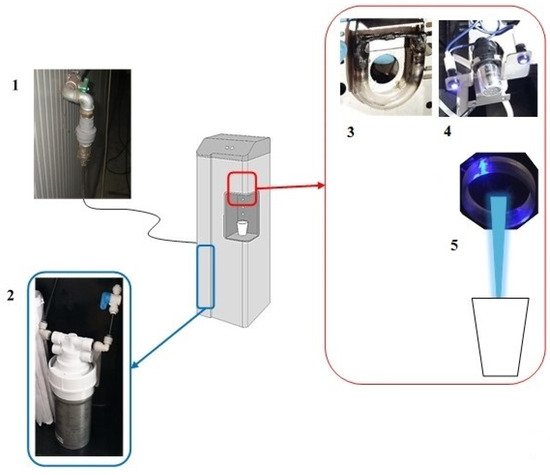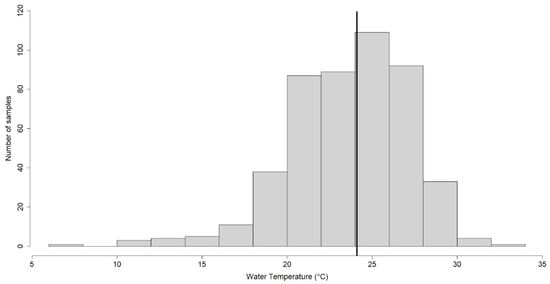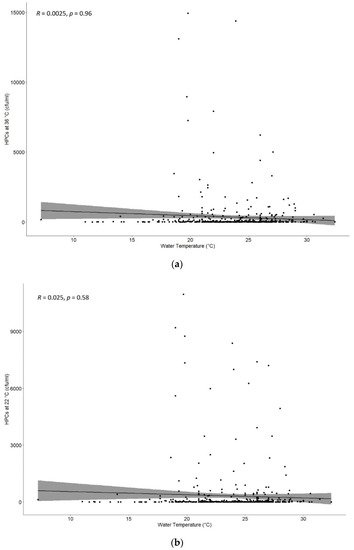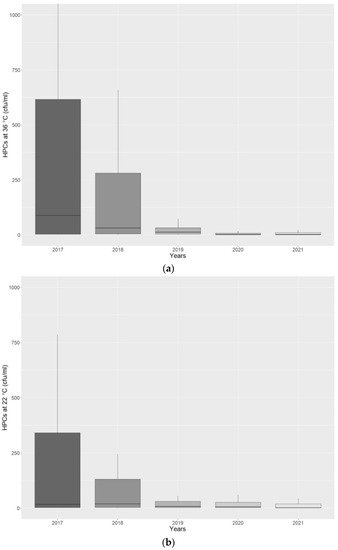The use of Microfiltered Water Dispensers (MWDs) is increasing in offices, companies, or commercial facilities, as a response to plastic pollution. Despite their widespread use, poor data are available about the water quality and pathogens developed. Starting from a high contamination found in MWDs, a Water Safety Plan (WSP) was implemented on 57 MWDs to improve the water quality. To assess the effectiveness of WSP during the period 2017–2021, the environmental monitoring of heterotrophic plate counts (HPCs) at 36 °C and 22 °C, Enterococcus spp., Pseudomonas aeruginosa, Escherichia coli, Staphylococcus aureus, and Clostridium perfringens, as prescribed by Italian regulation for drinking water, was conducted. A high level of HPCs at both temperatures was observed, over the regulation limit; contrarily, the pathogenic bacteria were absent. The contamination found was studied with respect to the temperature threshold of 25 °C, suggested by directives. No significant differences were found between samples above and below the threshold, while a significant decrease over the years was observed for HPCs at 36 °C (p = 0.0000000001) and 22 °C (p = 0.000006). The WSP implementation resulted in a 43.09% decrease for HPCs at 36 °C and a 24.26% decrease for HPCs at 22 °C. Moreover, during the SARS-CoV-2 pandemic, the WSP contributed to limit the microbial contamination, preserving the MWDs’ functionality and hygienic conditions and the drinking water quality.
- Water Safety Plan
- Microfiltered Water Dispensers
- maintenance and sanitation procedures
- drinking water quality
- water temperature
- heterotrophic plate counts' contamination
1. Introduction
2. Microfiltered Water Dispensers’ Characteristics

3. Studies of Water Dispenser
| MWDs’ Mean Contamination ± Standard Deviation (cfu/mL ± SD) | ||||||
|---|---|---|---|---|---|---|
| Microbiological Parameters | Girolamini et al., 2019 [20] (2015–2017) |
Present Study (2017–2021) | ||||
| 2017 | 2018 | 2019 | 2020 | 2021 | ||
| HPCs 36 °C | 1852 ± 0.67 | 1014.99 ± 2637.63 | 321.67 ± 802.31 | 39.05 ± 86.37 | 124.83 ± 766.07 | 30.02 ± 77.62 |
| HPCs 22 °C | 2437 ± 0.56 | 686.25 ± 1952.55 | 453.58 ± 1442.75 | 69.78 ± 374.89 | 161.50 ± 776.76 | 91.75 ± 469.23 |
| P. aeruginosa | 37.4 ± 0.81 | 9.48 ± 36.86 | 20.81 ± 59.50 | 2.18 ± 20.63 | 5.04 ± 27.58 | 0.67 ± 5.03 |
| Enterococcus spp. | 3.3 ± 0.20 | n.d. | n.d. | n.d. | n.d. | n.d. |
| E. coli | ||||||
| S. aureus | ||||||
| C. perfringens | n.d. | |||||



4. Conclusions
This entry is adapted from the peer-reviewed paper 10.3390/w13202905
References
- Reynolds, K.A.; Mena, K.D.; Gerba, C.P. Risk of waterborne illness via drinking water in the United States. Rev. Environ. Contam. Toxicol. 2008, 192, 117–158.
- Siddiqi, K.S.; Husen, A.; Rao, R.A.K. A review on biosynthesis of silver nanoparticles and their biocidal properties. J. Nanobiotechnol. 2018, 16.
- Zanacic, E.; McMartin, D.W.; Stavrinides, J. From source to filter: Changes in bacterial community composition during potable water treatment. Can. J. Microbiol. 2017, 63, 546–558.
- Chaidez, C.; Gerba, C.P. Comparison of the microbiologic quality of point-of-use (POU)-treated water and tap water. Int. J. Environ. Health Res. 2004, 14, 253–260.
- Sacchetti, R.; De Luca, G.; Dormi, A.; Guberti, E.; Zanetti, F. Microbial quality of drinking water from microfiltered water dispensers. Int. J. Hyg. Environ. Health 2014, 217, 255–259.
- Tingpej, P.; Tiengtip, R.; Kondo, S. Decontamination efficacy of ultraviolet radiation against biofilms of common nosocomial bacteria. J. Med. Assoc. Thail. 2015, 98, 582–588.
- Ministerial Decree n.25 07.02.2012. Technical Provisions Concerning Equipment for the Treatment of Water for Human Consumption. 2012. Available online: https://www.ausl.fe.it/azienda/dipartimenti/sanita-pubblica/servizio-igiene-alimenti/acqua-potabile-1/decreto-ministeriale-7-febbraio-2012-n-25-dispositivi-di-trattamento-acque/view (accessed on 1 August 2021).
- Zanetti, F.; De Luca, G.; Sacchetti, R. Control of bacterial contamination in microfiltered water dispensers (MWDs) by disinfection. Int. J. Food Microbiol. 2009, 128, 446–452.
- Uruén, C.; Chopo-Escuin, G.; Tommassen, J.; Mainar-Jaime, R.C.; Arenas, J. Biofilms as promoters of bacterial antibiotic resistance and tolerance. Antibiotics 2021, 10, 3.
- Vaz-Moreira, I.; Nunes, O.C.; Manaia, C.M. Ubiquitous and persistent Proteobacteria and other Gram-negative bacteria in drinking water. Sci. Total Environ. 2017, 586, 1141–1149.
- Al Moosa, M.E.; Khan, M.A.; Alalami, U.; Hussain, A. Microbiological Quality of Drinking Water from Water Dispenser Machines. Int. J. Environ. Sci. Dev. 2015, 6, 710–713.
- Slavik, I.; Oliveira, K.R.; Cheung, P.B.; Uhl, W. Water quality aspects related to domestic drinking water storage tanks and consideration in current standards and guidelines throughout the world—A review. J. Water Health 2020, 18, 439–463.
- European Union Council Directive 98/83/EC of 3 November 1998 on the quality of water intended for human consumption. Off. J. Eur. Communities 1998, 41, 32–54.
- Legislative Decree n.31 02.02.2001 Implementation of the Water Quality Directive 98/83/EC Relative to Water Quality Intended for Human Consumption. pp. 1–21. Available online: https://www.camera.it/parlam/leggi/deleghe/01031dl.htm (accessed on 1 August 2021).
- European Commission Directive (EU) 2015/1787 of 6 October 2015 amending Annexes II and III to Council Directive 98/83/EC on the Quality of Water Intended for Human Consumption. Off. J. Eur. Union. 2015. Available online: http://data.europa.eu/eli/dir/2015/1787/oj (accessed on 1 August 2021).
- Ministerial Decree 14.06.2017 Implementation of Directive (EU) 2015/1787 Amending Annexes II and III of Directive 98/83/EC on the Quality of Water Intended for Human Consumption. Amendments to Annexes II and III of Legislative Decree 2 February 2001, n. 31. 2017, pp. 14–19. Available online: http://www.si-t.eu/wordpress/wp-content/uploads/2017/09/6.pdf (accessed on 1 August 2021).
- Herschy, R.W. World Health Organization Guidelines for Drinking-Water Quality. Encycl. Lakes Reserv. 2011, 876–883. Available online: http://apps.who.int/iris/bitstream/handle/10665/44584/9789241548151_eng.pdf (accessed on 1 August 2021).
- Guidelines on Water Treatment Devices Guidelines on Water Treatment Devices Spent on Human Consumption under the D.M. 7 February 2012, n. 25. 2013. Available online: https://www.salute.gov.it/imgs/C_17_pubblicazioni_1946_allegato.pdf (accessed on 1 August 2021).
- European Parliament Regulation (EC) n. 852/2004 of the European Parliament and of the Council 29.04.2004 on the Hygiene of Foodstuffs. Off. J. Eur. Communities. 2004. Available online: https://www.certifico.com/chemicals/legislazione-chemicals/264-legislazione-chemicalsfood/4288-regolamento-ce-n-852-2004 (accessed on 1 August 2021).
- Girolamini, L.; Lizzadro, J.; Mazzotta, M.; Iervolino, M.; Dormi, A.; Cristino, S. Different trends in microbial contamination between two types of microfiltered water dispensers: From risk analysis to consumer health preservation. Int. J. Environ. Res. Public Health 2019, 16, 272.
- Agudelo-Vera, C.; Avvedimento, S.; Boxall, J.; Creaco, E.; de Kater, H.; Nardo, A.; Djukic, A.; Douterelo, I.; Fish, K.E.; Rey, P.L.G.; et al. Drinking water temperature around the globe: Understanding, policies, challenges and opportunities. Water 2020, 12, 1049.
- European Parliament Directive (EU) 2020/2184 of the European Parliament and of the Council of 16 December 2020 on the Quality of Water Intended for Human Consumption. Off. J. Eur. Communities. 2020, pp. 1–62. Available online: https://eur-lex.europa.eu/eli/dir/2020/2184/oj (accessed on 1 August 2021).
